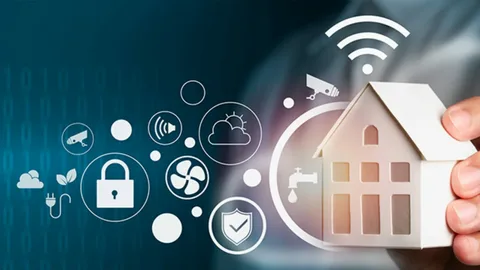How IoT is Transforming Smart Homes
The Internet of Things (IoT) is changing how we live in our spaces and creating the future of life that promises convenience, safety, and efficiency. With IoT, everyday devices can communicate over the internet, allowing users to manage many aspects of the home without having to do many taps on their smartphones. In this article, we examine how IoT influences smart homes by reducing energy consumption and improving security and how this technology will revolutionize the future of living.
Home functions Remote Control
The remote control capability of IoT is one of the most crucial ways to turn smart homes around. With IoT-based devices, homeowners can control almost all the various aspects of the home environment from anywhere. It is annoying to adjust the thermostat, control the lights, and manage home appliances without remote access, especially on the road. This level of control gives the user a better experience and makes devices less energy-hungry since controls can be controlled on the fly based on real-time needs, as opposed to fixed schedules.
Securing Integrity and Surveillance
IoT has offered to change the landscape of home security to allow real-time monitoring and automated notifications. Homeowners can remotely watch their property using smart cameras through IoT, motion detectors, and door sensors. Most of these devices possess AI-powered facial recognition and motion detection to detect unusual activity. IoT allows smart homes to instantly alert homeowners, or even local authorities, if there are likely to be suspicious activities, increasing their sense of security and peace of mind.
Smart Power Management and Energy Efficiency
IOT smart homes are built to be energy-driven, help reduce utility bills for owners, and be part of environmental sustainability. Smart thermostats, lighting systems, and appliances can adjust their settings automatically according to the occupancy of the place, weather conditions, and user habits. For instance, intelligent thermostats can learn your household’s routines and change the heating and cooling accordingly, minimizing energy consumption without compromising your comfort. IoT makes smart homes clever in using power, something traditional systems can’t do.
Voice Activated Assistance and Automation
Voice-activated assistants with IoT power are fast becoming a standard in many smart homes. Devices like Amazon Alexa, Google Assistant, and Apple’s Siri offer homeowners a way to control certain aspects of their homes through simple voice commands. These virtual assistants go from setting reminders and playing music to even controlling home automation systems; there are new ways to interact and be more convenient. Through integration with other IoT devices, voice-activated assistants offer seamless automation, helping reshape people’s relationships with their living spaces.
Low Climate Comfort
IoT is transforming climate and lighting control in homes, which can now be precisely controlled. Smart thermostats can learn how a user prefers his temperature and adjust it. In contrast, smart lighting systems can change intensity and color depending on the time of day or activity. With IoT-connected devices, even advanced sensors can measure air quality to adjust ventilation and improve air quality indoors. Combining climate and lighting control in smart homes makes living more comfortable and energy efficient and adds a higher level of personalized living to the experience.
Predictive maintenance and Smart Appliances
One more way IoT makes smart homes smart is by adding smart appliances. IoT-connected appliances aim for ease of use and the efficient use of your time, like refrigerators that read off the expiration dates of the food inside to make grocery shopping easier and washing machines that make noise when the laundry is complete. Thanks to the IoT, predictive maintenance is now possible, enabling appliances to monitor themselves for malfunctions before they materialize, leaving them to conduct repairs more expensive. This feature enables smart appliances to function most efficiently, increasing their life expectancy and the overall smart house experience.
Health and Wellness Monitoring
Thanks to IoT technology, it is now possible to monitor health and wellness in the home. Smart devices can monitor air quality, humidity, and temperature to promote health and create space for healthy living. Also, IoT devices monitor the vital signs (blood pressure, heart rate, etc.) of people managing chronic health conditions. IoT enables the proactive habit of healthy living with health and wellness monitoring embedded in smart homes.
Better Entertainment Systems
The IoT has made it possible to build home entertainment in new ways by connecting devices to create an enhanced experience. You can synchronize smart TVs, speakers, and streaming devices to ensure easy control over multiple rooms. Owners can set up their homes to accommodate personalized entertainment settings that automatically change lighting, sound, and screen selections. Internet of Things (IoT) connected entertainment systems also bring content to the customer’s fingertips with ease of use, such as controlling the media with the voice or smartphone. No other technology can achieve this customized and convenient home entertainment level but IoT.
Data-Driven Home Management
Improving the management of homes using data-driven insights is one of the underlying benefits of IoT in smart homes. IoT devices collect data on how a user behaves, how much energy a user draws, and environmental factors, which can be gathered to optimize different home functions. For example, smart thermostats and lighting systems can reveal patterns that help homeowners conserve energy, and smart appliances can show patterns that help homeowners learn when they may need repairs. The result of this data-driven approach is that smart homes can become more adaptive and efficient without increasing the demand for resources, thereby improving the overall living experience over time.
Conclusion
Rapidly transforming the smart home concept of smart homes, IoT is making daily living more convenient, secure, and energy efficient. IoT technology may revolutionize how we engage with our living spaces by providing remote control, improving security, saving energy, and delivering data-based insights. The IoT marks the future of residential life with advancements in voice-activated assistance, smart appliances, and health monitoring. This technology will only improve; as it does, smart homes will be a huge part of our lives today.


















